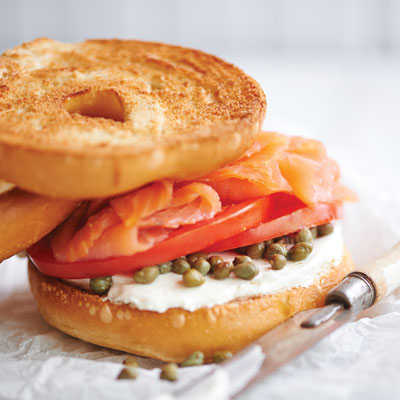Making a mark on holiday tradition with homemade lox
In the Jewish religion, holidays mean food – a whole lot of food. Growing up, we’d clamor into the car to drive to Memphis and ring in the Jewish new year with my grandma and grandpa over a spread that lasted three glorious days. (Sure, there were services, but I just remember the sweet, pull-apart challah that we dipped in a golden puddle of honey.)
When Passover rolled around each spring, my Baba made a cauldron of soup that was so flawless – light-as-air matzo balls bobbing in a broth that tasted of rich chicken, sweet carrots and fragrant herbs – it actually made me wonder what all the fuss about bread was anyway.
And every year when we light the candles for Hanukkah, my mom serves her legendary brisket – a tough cut reared tender thanks to a two-day Jacuzzi in a sticky-sweet tomato sauce. These are my holidays. Everything else is just a reason to come to the table.
As I inch into the finale of my 20s, I’m beginning to wonder how I can make my mark on cultural traditions that have had a decades-long head start. After all, why mess with perfection? (In case you’re wondering, that’s exactly what my mom’s brisket is.) Somewhere in between peeling russets for my Zada’s mashed potatoes and onions, and baking my mom’s citrus-scented blintz casserole, I realized that there was only one way to transition myself from hungry guest to gracious host: lox. Everyone loves it; no one makes it.
When you grow up in a Jewish home, lox is how you communicate. At 13, all bright-eyed and brace-faced (with 200 of your “closest” friends and family remarking, “Wow, I only heard your voice crack twice during your haftorah.”), you awkwardly cross that bridge into adulthood with freshly toasted bagels, a good schmear and lots of fatty lox.
You graduated high school? Have some bagels, lox and a gift card to Bed, Bath and Beyond. A new baby? You’ve got your hands full; I’ll bring the lox. When there’s a tragedy, tray after tray of everything bagels, slivers of bright purple onions, tubs of chive-studded cream cheese and shavings of sun-orange lox seemingly appear out of thin air. And this month, as we forgo food and water to repent for all the gossiping and scheming we’ve done this year, we’ll welcome our zombie-like bodies back to civilization with toasty bagels and salty lox.
But first thing’s first. Before I could make lox, I had to figure out what exactly it was. These days, lox is used as a catchall term for anything that’s orange, salty, sliced from the flesh of a salmon and folds like a ribbon atop a toasty bagel half. But in the 1800s, people were more specific. Unlike Nova, an Atlantic salmon that was smoked, lox (derived from laks, the Yiddish word for salmon) referred to fillets of Pacific salmon that were cured in a super-salty brine – and, importantly, not smoked. Barrels of lox took the trip across the transcontinental railroad to New York City, where Eastern European Jews fell for its salty flavor and ready-to-eat nature.
Because of lox’s longevity in the Big Apple, it seemed like a logical place to start. I cracked open The Mile End Cookbook by Noah and Rae Bernamoff, a couple who is reinventing classic Montreal Jewish fare at their from-scratch delis in Brooklyn and Manhattan. Next, I dug into the archives of Michael Ruhlman, famed food blogger and master at deciphering kitchen techniques.
Luckily for me, both books offered recipes for homemade lox. Unluckily for me, the techniques were utter opposites. While the Bernamoffs recommended a six-day stint of cure, rinse, repeat, Ruhlman consolidated the whole process into just two days. I tried both.
A few days in, Ruhlman’s recipe left me with a fillet that had the look and taste of sushi. (Great for a rainbow roll. Not so great for a bagel.) Four days later, the Bernamoffs’ version yielded tender, rich lox that had a melting texture, just the right amount of salt and a faint hint of dill. For my next batch, I doubled the black peppercorns and fresh dill sprigs. Bingo.
Though lox is traditionally made with king salmon, the über-friendly fishmongers at Bob’s Seafood pointed me to Scottish fillets that are big on flavor for about half the cost. But if you don’t mind throwing down $28 per pound, then by all means, all hail the king. Another trick from my friends at Bob’s: Look for farmed fillets, since wild salmon will be too lean to fully absorb the salty cure.
As for the cure, kosher salt will be the dominant flavoring agent for the lox, so don’t cut corners. Take time to track down a top-notch brand like Diamond Crystal, known for its coarse texture and smooth flavor, if you can. If not, Morton will get the job done. The most important thing to remember is to get the ratio of salt-to-sugar exact, running the sugar granules through your fingers to make sure that there are no clumps, as this is the brine that will essentially be “cooking” the fish.
The toughest part of the entire process is slicing. As Ruhlman explained in his book Ruhlman’s Twenty, lox should be sliced so thin you could read a newspaper through it. Easier said than done.
Start with a very sharp chef’s knife, then cut off the top layer of the fish, which will have hardened during the curing and drying process. Next, work your way down one side of the fish at an angle, moving slowly to cut so thinly that you can see the knife through your slice the entire time. This takes practice, but if a few thicker pieces land on the table at break fast this year, I promise no one will mind.
Once you master the technique, you can play around with replacing the white sugar with brown for a sweeter version or switching out the dill and black pepper for citrus zest to get a tangier, lighter slice. This Yom Kippur, though, I think I’ll stick with the classics. Even I don’t have the chutzpah to mess with perfection.

Lox
Adapted from a recipe by Noah and Rae Bernamoff, as published in The Mile End Cookbook
8 to 10 servings
1 2-lb. boneless Scottish or king farmed salmon fillet, skin-on*
2/3 cup whole black peppercorns
2/3 cup sugar
1 cup kosher salt (preferably Diamond Crystal, can also use Morton)
2 bunches fresh dill
For serving:
8 to 10 bagels
Cream cheese
Red onion, sliced
Tomato, sliced
Capers, drained
• Wash the salmon and pat dry. Turn the fish skin-side-up and, using a very sharp knife, cut 3 equally spaced, shallow cuts into the skin. Set aside.
• Combine the peppercorns, sugar and salt in a bowl. Break up any lumps in the sugar with your fingers and stir, making sure the sugar and salt are thoroughly combined.
• Place 4 to 6 sprigs of dill in the bottom of a large nonreactive baking dish. Sprinkle ¼ cup of the sugar and salt mixture on the bottom of the dish.
• Place the salmon skin-side-down in the baking dish atop the dill and sugar and salt mixture.
• Place another 4 to 6 dill sprigs atop the salmon. Sprinkle with another ¼ cup of the sugar and salt mixture. Loosely cover the baking dish with plastic wrap and place in the fridge for 24 hours.
• Transfer the salmon from the baking dish to a clean plate or cutting board. Pour off any liquid that has accumulated in the baking dish. Discard the dill sprigs in the bottom of the dish and replace with 4 to 6 new sprigs. Add another ¼ cup of the sugar and salt mixture to the bottom of the dish, and place the salmon back in the dish, skin-side-down. Replace the dill sprigs atop the salmon with 4 to 6 new sprigs and sprinkle with another ¼ cup of the sugar and salt mixture. Cover loosely with plastic wrap and refrigerate for another 24 hours.
• Repeat this process 2 more times.
• On the fifth day, remove the salmon from the baking dish. Rinse the fish well and pat dry with paper towels. Place a drying rack over 2 layers of paper towels. Place the salmon on the drying rack and refrigerate, uncovered, overnight.
• On the sixth day, the salmon is ready for slicing and serving. Using a very sharp chef’s knife, carefully slice off only the very top layer of the salmon in several pieces. Discard. Next, work at an angle to slice very thin slices of salmon, moving from one end of the fish to the other. The slices should be so thin that you can see the knife through the fish at all times. Continue until you have sliced the entire fish.
• Serve with freshly toasted bagels, cream cheese, sliced red onion, freshly sliced summer tomatoes and a sprinkle of capers.
*Get the freshest catch from Bob’s Seafood in University City
**Find them plump and perfect at The Bagel Factory in Creve Coeur
Stacy Schultz is a longtime contributor to Sauce Magazine.







